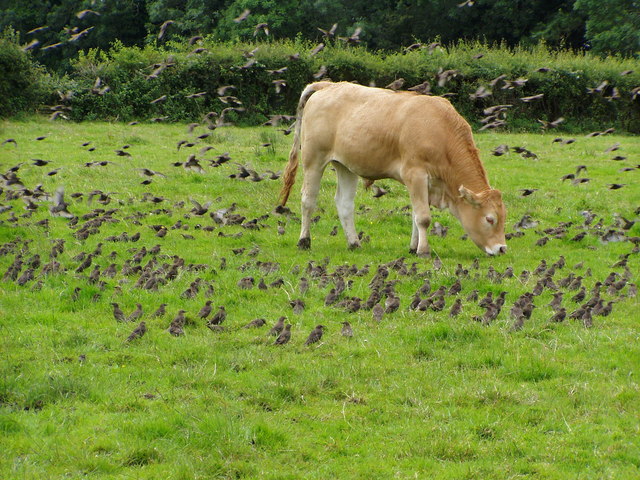|
Brown-headed Cowbird
The brown-headed cowbird (''Molothrus ater'') is a small, obligate brood parasitic icterid native to temperate and subtropical North America. It is a permanent resident in the southern parts of its range; northern birds migrate to the southern United States and Mexico in winter, returning to their summer habitat around March or April. Taxonomy The brown-headed cowbird was described by the French polymath Georges-Louis Leclerc, Comte de Buffon in 1775 in his '' Histoire Naturelle des Oiseaux'' from a specimen collected in the Carolinas. The bird was also illustrated in a hand-colored plate engraved by François-Nicolas Martinet in the ''Planches Enluminées D'Histoire Naturelle'', which was produced under the supervision of Edme-Louis Daubenton to accompany Buffon's text. Neither the plate caption nor Buffon's description included a scientific name, but in 1783, Dutch naturalist Pieter Boddaert coined the binomial name ''Oriolus ater'' in his catalogue of the ''Planches Enlumin ... [...More Info...] [...Related Items...] OR: [Wikipedia] [Google] [Baidu] |
Pieter Boddaert
Pieter Boddaert (1730 – 6 May 1795) was a Dutch physician and naturalist. Early life, family and education Boddaert was the son of a Middelburg jurist and poet by the same name (1694–1760). The younger Pieter obtained his M.D. at the University of Utrecht in 1764. Career He became a lecturer on natural history at his alma mater, University of Utrecht. Fourteen letters survive of his correspondence with Carl Linnaeus between 1768 and 1775. He was a friend of Albert Schlosser, whose cabinet of "curiosities" of natural history he described. In 1783 he published 50 copies of an identification key of Edmé-Louis Daubenton's ''Planches enluminées'', the colored plates of illustrations for the comte de Buffon's monumental ''Histoire Naturelle'' (published 1749–1789), assigning binomial scientific names to the plates. As many of these were the first Linnaean scientific names to be proposed, they remain in use. In 2017 the world list of birds maintained by Frank Gill and David ... [...More Info...] [...Related Items...] OR: [Wikipedia] [Google] [Baidu] |
Ancient Greek
Ancient Greek (, ; ) includes the forms of the Greek language used in ancient Greece and the classical antiquity, ancient world from around 1500 BC to 300 BC. It is often roughly divided into the following periods: Mycenaean Greek (), Greek Dark Ages, Dark Ages (), the Archaic Greece, Archaic or Homeric Greek, Homeric period (), and the Classical Greece, Classical period (). Ancient Greek was the language of Homer and of fifth-century Athens, fifth-century Athenian historians, playwrights, and Ancient Greek philosophy, philosophers. It has contributed many words to English vocabulary and has been a standard subject of study in educational institutions of the Western world since the Renaissance. This article primarily contains information about the Homeric Greek, Epic and Classical periods of the language, which are the best-attested periods and considered most typical of Ancient Greek. From the Hellenistic period (), Ancient Greek was followed by Koine Greek, which is regar ... [...More Info...] [...Related Items...] OR: [Wikipedia] [Google] [Baidu] |
Seed
In botany, a seed is a plant structure containing an embryo and stored nutrients in a protective coat called a ''testa''. More generally, the term "seed" means anything that can be Sowing, sown, which may include seed and husk or tuber. Seeds are the product of the ripened ovule, after the embryo sac is fertilization, fertilized by Pollen, sperm from pollen, forming a zygote. The embryo within a seed develops from the zygote and grows within the mother plant to a certain size before growth is halted. The formation of the seed is the defining part of the process of reproduction in seed plants (spermatophytes). Other plants such as ferns, mosses and marchantiophyta, liverworts, do not have seeds and use water-dependent means to propagate themselves. Seed plants now dominate biological Ecological niche, niches on land, from forests to grasslands both in hot and cold climates. In the flowering plants, the ovary ripens into a fruit which contains the seed and serves to disseminate ... [...More Info...] [...Related Items...] OR: [Wikipedia] [Google] [Baidu] |
Cattle
Cattle (''Bos taurus'') are large, domesticated, bovid ungulates widely kept as livestock. They are prominent modern members of the subfamily Bovinae and the most widespread species of the genus '' Bos''. Mature female cattle are called cows and mature male cattle are bulls. Young female cattle are called heifers, young male cattle are oxen or bullocks, and castrated male cattle are known as steers. Cattle are commonly raised for meat, for dairy products, and for leather. As draft animals, they pull carts and farm implements. Cattle are considered sacred animals within Hinduism, and it is illegal to kill them in some Indian states. Small breeds such as the miniature Zebu are kept as pets. Taurine cattle are widely distributed across Europe and temperate areas of Asia, the Americas, and Australia. Zebus are found mainly in India and tropical areas of Asia, America, and Australia. Sanga cattle are found primarily in sub-Saharan Africa. These types, sometime ... [...More Info...] [...Related Items...] OR: [Wikipedia] [Google] [Baidu] |
European Starling
The common starling (''Sturnus vulgaris''), also known simply as the starling in Great Britain and Ireland, and as European starling in North America, is a medium-sized passerine bird in the starling family, Sturnidae. It is about long and has glossy black plumage with a metallic sheen, which is speckled with white at some times of the year. The legs are pink and the bill is black in winter and yellow in summer; young birds have browner plumage than the adults. Its gift for mimicry has been noted in literature including the ''Mabinogion'' and the works of Pliny the Elder and William Shakespeare. The common starling has about 12 subspecies breeding in open habitats across its native range in temperate Europe and across the Palearctic to western Mongolia, and it has been introduced as an invasive species to Australia, New Zealand, Canada, the United States, Mexico, Argentina, South Africa and Fiji. This bird is resident in western and southern Europe and southwestern Asia, whil ... [...More Info...] [...Related Items...] OR: [Wikipedia] [Google] [Baidu] |
Common Grackle
The common grackle (''Quiscalus quiscula'') is a species of large icterid bird found in large numbers through much of North America. First described in 1758 by Carl Linnaeus, the common grackle has three subspecies. Adult common grackles have a long and dark bill, pale yellow eyes, and a long tail. Adults often have a bluish iridescent appearance on their head, especially males. Common grackles can be found widely across North America east of the Rocky Mountains. Taxonomy The common grackle was first described in 1758 by Carl Linnaeus in the 10th edition of Systema Naturae, tenth edition of ''Systema Naturae'', as ''Gracula quiscula''. It was assigned to the genus ''Quiscalus'' by French people, French ornithologist Louis Pierre Vieillot in his 1816 ''Dictionnaire d'histoire naturelle''. Three subspecies are recognized: *the Florida grackle (''Q. q. quiscula'') (Linnaeus 1758), the nominate subspecies *the purple grackle (''Q. q. stonei'') (Chapman, 1935) *the bronzed grackle ... [...More Info...] [...Related Items...] OR: [Wikipedia] [Google] [Baidu] |
Bobolink
The bobolink (''Dolichonyx oryzivorus'') is a small New World blackbird and the only member of the genus ''Dolichonyx''. An old name for this species is the "rice bird", from its tendency to feed on cultivated grains during winter and migration. The bobolink breeds in the summer in the United States and Canada, with most of the summer range in the northern U.S. Bobolinks winter in southern South America, primarily Paraguay, Argentina, and Bolivia. Bobolink numbers are rapidly declining due to factors such as agricultural intensification and habitat loss; they are considered threatened in Canada, and are at risk throughout their range. Taxonomy The bobolink was formally described in 1758 by the Swedish naturalist Carl Linnaeus in the tenth edition of his ''Systema Naturae''. He placed it with the finches in the genus '' Fringilla'' and coined the binomial name ''Fringilla oryzivora''. Linnaeus mainly based his account on "The Rice-Bird" that had been described and illustrated in ... [...More Info...] [...Related Items...] OR: [Wikipedia] [Google] [Baidu] |
Red-winged Blackbird
The red-winged blackbird (''Agelaius phoeniceus'') is a passerine bird of the family Icteridae found in most of North America and much of Central America. It breeds from Alaska and Newfoundland south to Florida, the Gulf of Mexico, Mexico, and Guatemala, with isolated populations in western El Salvador, northwestern Honduras, and northwestern Costa Rica. It may winter as far north as Pennsylvania and British Columbia, but northern populations are generally migratory, moving south to Mexico and the Southern United States. Claims have been made that it is the most abundant living land bird in North America, as bird-counting censuses of wintering red-winged blackbirds sometimes show that loose flocks can number in excess of a million birds per flock and the full number of breeding pairs across North and Central America may exceed 250 million in peak years. It also ranks among the best-studied wild bird species in the world. The red-winged blackbird is sexually dimorphic; the male i ... [...More Info...] [...Related Items...] OR: [Wikipedia] [Google] [Baidu] |
Iridescence
Iridescence (also known as goniochromism) is the phenomenon of certain surfaces that appear gradually to change colour as the angle of view or the angle of illumination changes. Iridescence is caused by wave interference of light in microstructures or thin films. Examples of iridescence include soap bubbles, feathers, butterfly wings and seashell nacre, and minerals such as opal. Pearlescence is a related effect where some or most of the reflected light is white. The term pearlescent is used to describe certain paint finishes, usually in the automotive industry, which actually produce iridescent effects. Etymology The word ''iridescence'' is derived in part from the Greek word ἶρις ''îris'' ( gen. ἴριδος ''íridos''), meaning ''rainbow'', and is combined with the Latin suffix ''-escent'', meaning "having a tendency toward". Iris in turn derives from the goddess Iris of Greek mythology, who is the personification of the rainbow and acted as a messenger of th ... [...More Info...] [...Related Items...] OR: [Wikipedia] [Google] [Baidu] |
Finch
The true finches are small to medium-sized passerine birds in the family Fringillidae. Finches generally have stout conical bills adapted for eating seeds and nuts and often have colourful plumage. They occupy a great range of habitats where they are usually resident and do not migrate. They have a worldwide native distribution except for Australia and the polar regions. The family Fringillidae contains more than two hundred species divided into fifty genera. It includes the canaries, siskins, redpolls, serins, grosbeaks and euphonias, as well as the morphologically divergent Hawaiian honeycreepers. Many birds in other families are also commonly called "finches". These groups include the estrildid finches ( Estrildidae) of the Old World tropics and Australia; some members of the Old World bunting family ( Emberizidae) and the New World sparrow family ( Passerellidae); and the Darwin's finches of the Galapagos islands, now considered members of the tanager family (Th ... [...More Info...] [...Related Items...] OR: [Wikipedia] [Google] [Baidu] |





